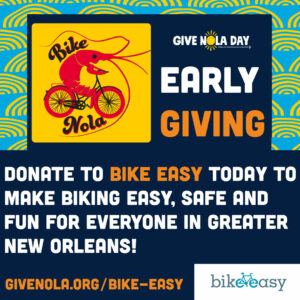On Friday, I had my first experience riding on the new & improved stretch of Marconi Dr / Orleans Ave that runs along City Park and Delgado Community College. It was glorious! The protected bike lanes, green paint highlighting the bike lane at intersections, and smooth road surface all felt safe and comfortable.
Even better, I was on my way to the ribbon-cutting for this great project that exemplifies what we mean when we say “complete streets”. Along with the protected bike lanes, there are improved sidewalks and pedestrian crossings, better bus stops, traffic calming strategies, and the whole street was repaved. This feeling of safety and accessibility is what people should be experiencing when heading to the park or to school, no matter how they’re traveling.
At the press conference, it became clear just how much this is the right approach for the location. The Chancellor of Delgado spoke of the over 10,000 students each semester who come to that campus, and all the various means of transportation that they use. The CEO of City Park discussed safe accessibility to this huge greenspace that is enjoyed in so many different ways.
Even beyond this particular spot, the complete streets approach just makes sense in general. As I was chatting with Secretary Shawn Wilson from the Louisiana Department of Transportation and Development, he shared his excitement to use this incredible project as an example in other communities around the state that are looking to understand how to promote alternative transportation options.
Complete streets are built to benefit all people, whether you’re driving, walking, biking, taking the bus, or rolling in a wheelchair. Everyone can have peace on the road when we’ve all got a piece of the road. Good bike infrastructure makes things safer for everyone, including people driving. Good bike infrastructure gets people riding to follow the rules and makes things more enjoyable for everyone. Improving alternative transportation options, including bicycling and transit, will help reduce congestion and parking demand. The benefits go on and on!
Despite all these proven benefits there are, as Mayor Cantrell pointed out during the press conference, some naysayers for projects like these. I certainly understand that changes can be uncomfortable, especially when there are periods of construction, tradeoffs and major reorganizations of the roadway. However, as we’ve seen time and again, when these projects are done correctly, the temporary discomfort goes away once people get used to the new arrangement and the end result is even more comfortable, safe, and livable streets for everyone.
The New Orleans Complete Streets Coalition and supportive neighbors worked hard to highlight the widespread benefits of the Marconi project in the face of sometimes nasty, yet misguided, opposition. As Rica Trigs, Community Advocacy Director for the American Heart Association, spoke on behalf of the Coalition at the press conference, the Mayor and others made it clear that they appreciated that work. And there was quite a crowd of Coalition members and community supporters at the ribbon-cutting!
I’m grateful that the Mayor and other decision-makers maintained their resolve for implementing a vision that prioritizes safety and accessibility for everyone on Marconi, and I look forward to working hard to engage the community and build support for many more projects!
One of the most exciting parts of the Marconi project is how it fits into the City’s overall Moving New Orleans Bikes comprehensive vision for a comprehensive of low-stress, connected networks. Soon, construction will start on a bike path that runs through City Park and connects directly to the new two-way cycle track on Marconi. That all plays into the rapid expansion of the low-stress bikeway network that will connect neighborhoods throughout the city.
The future of biking in New Orleans is bright!

